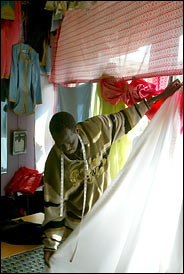More Africans Enter U.S. Than in Days of Slavery
By SAM ROBERTS
Published: February 21, 2005, New York Times
For the first time, more blacks are coming to the United States from Africa than during the slave trade.
Since 1990, according to immigration figures, more have arrived voluntarily than the total who disembarked in chains before the United States outlawed international slave trafficking in 1807. More have been coming here annually - about 50,000 legal immigrants - than in any of the peak years of the middle passage across the Atlantic, and more have migrated here from Africa since 1990 than in nearly the entire preceding two centuries.
New York State draws the most; Nigeria and Ghana are among the top 20 sources of immigrants to New York City. But many have moved to metropolitan Washington, Atlanta, Chicago, Los Angeles, Boston and Houston. Pockets of refugees, especially Somalis, have found havens in Minnesota, Maine and Oregon.
The movement is still a trickle compared with the number of newcomers from Latin America and Asia, but it is already redefining what it means to be African-American. The steady decline in the percentage of African-Americans with ancestors who suffered directly through the middle passage and Jim Crow is also shaping the debate over affirmative action, diversity programs and other initiatives intended to redress the legacy of slavery.
In Africa, the flow is contributing to a brain drain. But at the same time, African-born residents of the United States are sharing their relative prosperity here by sending more than $1 billion annually back to their families and friends.
"Basically, people are coming to reclaim the wealth that's been taken from their countries," said Howard Dodson, director of the Schomburg Center for Research in Black Culture, in Harlem, which has just inaugurated an exhibition, Web site and book, titled "In Motion," to commemorate the African diaspora.
The influx has other potential implications, from recalibrating the largely monolithic way white America views blacks to raising concerns that American-born blacks will again be left behind.
"Historically, every immigrant group has jumped over American-born blacks," said Eric Foner, the Columbia University historian. "The final irony would be if African immigrants did, too."
The flow from Africa began in the 1970's, mostly with refugees from Ethiopia and Somalia, and escalated in the 1990's, when the number of black residents of the United States born in sub-Saharan Africa nearly tripled. Combined with the much larger flow of Caribbean blacks, the recent arrivals from Africa accounted for about 25 percent of black population growth in the United States over all during the decade. Nationally, the proportion of blacks who are foreign born rose to about 7.3 percent from 4.9 percent in the 1990's. In New York City, about 1 in 3 blacks are foreign born.
According to the census, the proportion of black people living in the United States who describe themselves as African-born, while still small, more than doubled in the 1990's, to 1.7 percent from about 0.8 percent, for a total estimated conservatively at more than 600,000. About 1.7 million United States residents identify their ancestry as sub-Saharan.
Those numbers reflect only legal immigrants, who have been arriving at the rate of about 50,000 a year, first mostly as refugees and students and more recently through family reunification and diversity visas. Many speak English, were raised in large cities and capitalist economies, live in families headed by married couples and are generally more highly educated and have higher-paying jobs than American-born blacks.
There is no official count of the many others who entered the country illegally or have overstayed their visas and who are likely to be less well off.
Kim Nichols, co-executive director of the African Services Committee, which directs newcomers to health care, housing and other services in the New York region, estimates that the number of illegal African immigrants dwarfs the legal ones. "We think it's a multiple of at least four," she said.
Africans' reasons for coming echo the aspirations of earlier immigrants.
"Senegal became too small," said Marie Lopy, who arrived as a student in 1996, worked as a bookkeeper in a restaurant and earned an associate degree in biology from the City University of New York.
http://www.nytimes.com/2005/02/21/nyregion/21africa.html?ex=1109653200&en=c164ab867f6bf987&ei=5070
--





